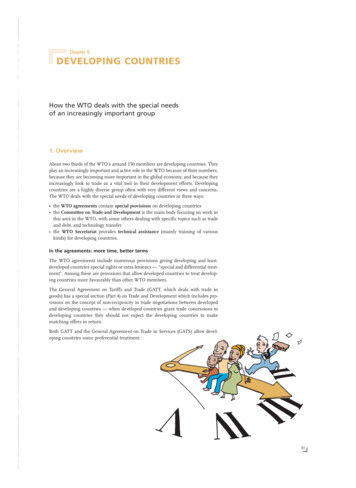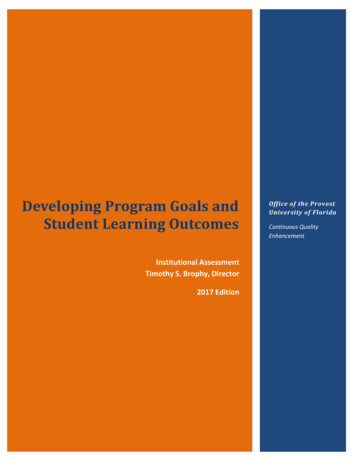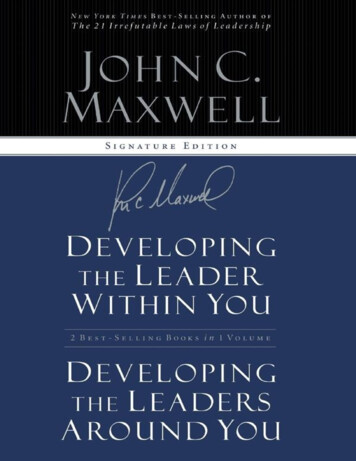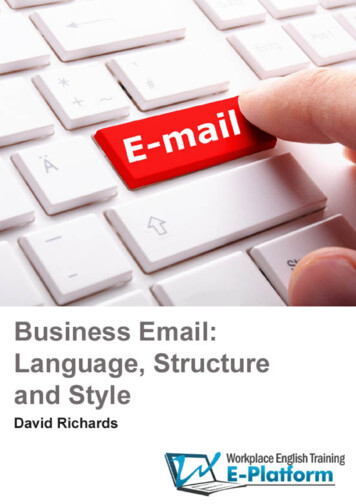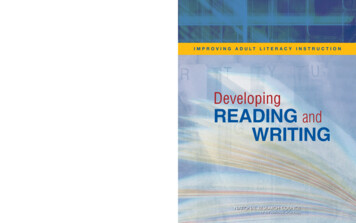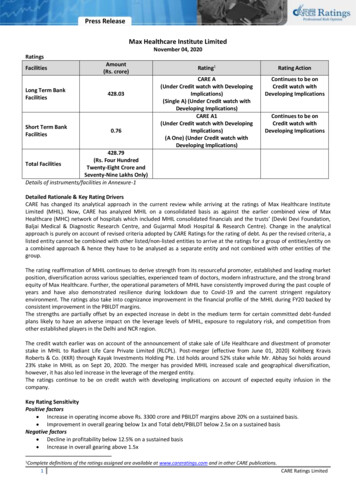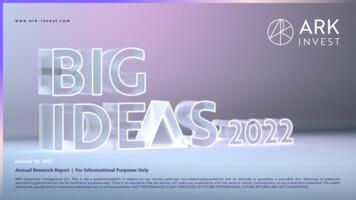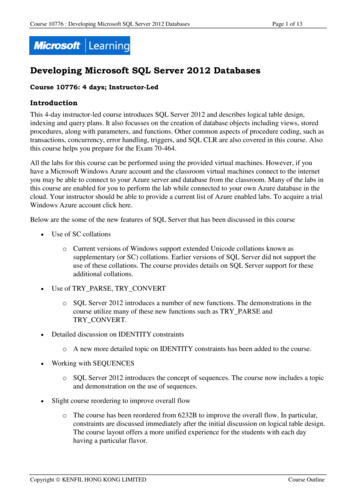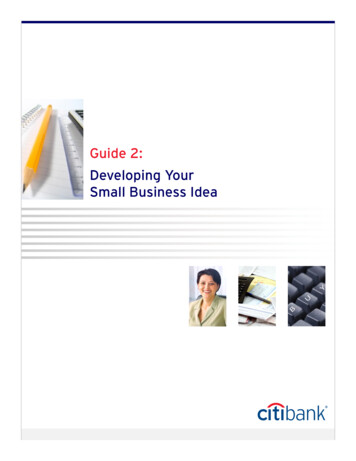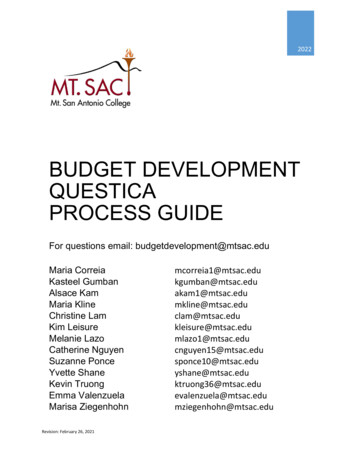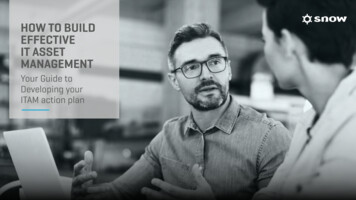
Transcription
HOW TO BUILDEFFECTIVEIT ASSETMANAGEMENTYour Guide toDeveloping yourITAM action plan
CONTENTSDeveloping Your ITAM Action Plan2Establishing Your Goals3Put a Policy in Place4Creating Standards and Guidelines5Drafting Processes and Procedures6People, Tools and Technologies7Dealing with Data7Structuring Your ITAM Team9The Stakeholder Explosion11Making It Personal: Designing A Process That Works for You12
PART II: DEVELOPING YOUR ITAM ACTION PLANIT Asset Managers often talk about standards and best practices. But the single most important thingto remember about standards and best practices is that they are just guidelines. As such, they are notdesigned to dictate exactly what an individual organization should be doing and how they should bedoing it. Rather than treating such guidelines as prescriptive, IT asset managers should use them as astarting point and take from them the things that will help their organization achieve its desired goals.Read our practical guide tocreating an ITAM action plan, thatmakes the most of best practicebut still flexes to the needs of theindividual organization.
GETTING STARTEDESTABLISHINGYOUR GOALSFigure 1: Taking a top down approach to ITAM governanceEffective ITAM starts with two things: amission statement and a charter. Thesedocuments don't have to be hugely longand detailed, but they will form the basis ofhow you put your ITAM capability together.Your goals should reflect your organization'smission statement and objectives, and yourcharter needs to put in place the detailsof the stakeholders and the governancemethodology that you're going to use.Mission & CharterPolicyStandards & Guidelines01Processes & ProceduresPeople & AutomationSource: Snow Software June 2018There are many different ways of doingthis. Larger organizations might establisha dedicated ITAM steering group or auditcommittee to report into, while smallerorganizations might report to the CFO orCIO, a head of governance or an IT director.The important thing is to have a processin place to show what progress is beingmade, what actions have been taken andwhat issues there have been, together withdocumentation that describes how andwhen these reports will be made.3
PUT A POLICY IN PLACEBy putting a policy in place, you are providing ITAM with its remit.Above all, this policy must be accessible.Every organization is dependent on digital technology. Everybody within an organization uses digitaltechnology in some way, shape, or form. As a result, the ITAM policy has implications for all of themand they need to be able to understand it.Ideally an ITAM policy document should be short, concise and written in very plain, accessiblelanguage that is meaningful to all your stakeholders. For international organizations, that meansensuring the document is translated into local languages. This helps ensure there is total clarityabout what the rules are around the use of your IT assets.Putting a policy in place can seem daunting, but it should be straightforward, and there are only tworules you need to follow: Keep it brief – The ideal length for a policy is two to three pages. eep it relevant – Remember that the purpose of the policy statement is to help end usersKunderstand how they can and can't use the IT assets at their disposal. Any content that isn’trelevant to them should be eliminated.If you feel unsure of where to start, seek the advice of your security and risk management teams.They are often experts in governance structure and will have templates you can use to get started.In some cases, they may even be able to share advice from professional advisors around policybuilding and communication.4
CREATING STANDARDS AND GUIDELINESOnce you have drafted your policy statement, you can move on to the standards and guidelinesthat will help IT administer the organization’s assets and manage them on a day to day basis. Hereare some useful tips to get you started: ake a clear distinction between standards, which are mandatory, and guidelines,Mwhich are optional. ake sure your guidelines address all the stakeholders responsible for the daily care of ITMassets, from system administrators to end user support teams. lign your guidelines with the scope of your IT function to ensure everyone involved inAmanaging assets has the information they need to do their job. This could include:Architectural standardsISO standardsRelated security policiesAcceptable use policies5
DRAFTING PROCESSES AND PROCEDURESWith your standards and guidelines in place, you can move on to the more detailed ITAM processesand procedures. Processes are high-level, generic descriptions of ITAM activity. Typically, theywill have long-term application and will not need to be updated very often, although they shouldbe reviewed annually. Individual procedures will be more detailed and will vary according tocircumstances. For example, within the support and maintenance renewals process there will bedetailed procedures for dealing with vendor specific renewals.Figure 2 - Core IT Asset Management ProcessesiAsset DataReconcileConsumption DataInvestigateRemediate & OptimiseSource: Snow Software, June 20186
PEOPLE, TOOLS AND TECHNOLOGIESOnce your policy, processes and procedures are in place, they are ready to be supported by theright people, tools and technologies. The volumes of data that we have to deal with in ITAM aresignificant, so automation is key to success.DEALING WITH DATAOne of the reasons automation is so important within the context of ITAM is that many coreprocesses revolve around data. In essence, ITAM is about comparing two sets of data: entitlementdata and consumption data (see Figure 2). It’s worth noting that consumption is not the same asusage. Consumption can be based on things that are as simple as having bought an asset or havingdeployed it somewhere.So, what do these two types of data involve? If we take software as an example, entitlement forany specific product may be made up of multiple documents: master contracts, work orders,purchase orders, invoices, end user license agreements, online terms and conditions. To measureconsumption against this entitlement, the ITAM team may have to gather multiple metricsor multiple pieces of information about a piece of software to be able to work out how it isbeing consumed. They will also need to think about factors such as geography, legal entity, theenvironment in which the software is running, the types of end points that are connecting to it, theamount and type of data that is being processed, and the employment status of the end user.7
DEALING WITH DATA CONTINUED.Once the data has been collected, it must be normalized to ensure that like is being compared withlike. Many products will have a number of different identifiers, or be identified in a different waydepending on how the information about them has been collected. As a result, it can be very difficultto match entitlements against deployed or accessed software. The normalization process makes itpossible to establish common identifiers.Normalized data can be reconciled to provide a clear overview of entitlement and consumption,as well as some exception reports. It’s important not to just assume that the exception reports arecorrect and instead to investigate them. For example, if the report suggests that the organizationdoesn’t have the right number of licenses, the first step is to check that the data is correct. Is theremore data somewhere? Has the data been inputted correctly? Are you collecting the right thing?Does everybody understand what it is you've asked them? Asking these questions makes it easier towork out why those exceptions are there and what the options are for dealing with them.8
STRUCTURING YOUR ITAM TEAMThere are three or four distinct roles within ITAM – but that doesn’t mean that every organization needs three or fourpeople in their ITAM team. Some may need more – others will need fewer. In some organizations, all these roles orfunctions will form part of one IT asset manager’s job. Some organizations may not even have a dedicated IT assetmanager. So, while below we will treat these roles separately, it is important to remember that they are not job titles.Whatever the scope of the organization and its ITAM function, the key is to make sure that all of the activities carriedout as part of these roles are fulfilled in some way.Figure 3 – Sample ITAM Organization StructureCIOCFOIT GovernanceIT FinanceIT AssetManagerIT AssetAnalystSoftwareAsset AnalystIT AssetAdministratorSource: Snow Software June 20189
STRUCTURING YOUR ITAM TEAM CONTINUED.The IT Asset Manager delivers an enabling service to the rest of the organizationand has overall responsibility for the running of the ITAM function. They mayhave specialist skills in this area and they may be supported by a team ofother specialists. This team might include professionals with general ITAMexperience who work as IT Asset Analysts to identify issues, conduct root causeanalysis, come up with solutions and ensure technology owners can optimizetheir assets. There might also be Software Asset Management Analysts or evenLicensing Analysts with specialist knowledge about specific software vendors,niche vendors that are relevant to the organization’s industry, the vendors withwhom the organization spends the most money or the vendors with whomthey've had the biggest problems in the past.There is a huge amount of administration involved in ITAM, much of whichrevolves around the purchase documentation and entitlement documentation.Although a lot of asset administration is done by the individuals who work withthe assets on a day to day basis and are responsible for ensuring that they'rekept up to date, the IT Asset Administrator will still have to do a lot of workwhen it comes to assessing the quality of information provided. The role alsoincludes ensuring that any assets that have been missed are added to thesystems. Early on in the ITAM journey, this will also include inputting legacy data.10
THE STAKEHOLDER EXPLOSIONThere are many stakeholders who are dependent on ITAM information in order to make decisions. Most of thesestakeholders sit within IT functions, and include enterprise architecture, infrastructure and operations, applicationsmanagement and the CTO. ITAM information is important to stakeholders outside the IT team, too, includingprocurement, vendor management, risk management and legal teams.Finally, there is an increasing demand from business units to have data about the technology that they are using and– more and more frequently – procuring. Industry estimates the proportion of technology being sourced and paid foroutside of IT vary from around 40-50% today increasing to 60-80% in the next couple of years. Although the figuresvary, there is clear consensus that this is happening and is going to continue to do so. Business units are going outand buying technology and technology services and they need accurate ITAM data to help them make the rightdecisions.IT Asset Managers need to think carefully about their relationships with all of these stakeholders and work onengaging with them, sharing information with them in a timely, relevant and consumable way, and supporting themin the decisions they make.Ultimately, ITAM as a function is about delivering governance in an integrated way.IT Asset Managers do have oversight of assets and the asset lifecycle, but they alsoeducate and engage stakeholders, helping them gain insights from meaningfulinformation, rather than looking at raw data. They provide reporting and resources tosupport effective management and administration of technology assets.11
MAKING IT PERSONAL: DESIGNING A PROCESS THATWORKS FOR YOUEstablishing – or even refreshing – your ITAM capability can seem like an impossible task. The sheer volume of datainvolved can seem overwhelming. With so much to deal with, it can be tempting to stick to the bare minimum, relyingon templates and best practice to keep things compliant and keep the business ticking over.Whatever your organization’s reasons for implementing ITAM, the underlying motivation is the same: empowering thebusiness to fulfil its mission. That mission is individual to your business – and the way you manage your assets shouldbe too. The top down approach we have outlined in this eBook empowers you to turn the challenging process ofdeveloping an ITAM function that works for you into a series of manageable chunks.As you look at the drivers for ITAM within the organization, as you categorize them and build your business case,and as you start to define your objectives, that mission should be your guiding principle. Keeping that mission atthe forefront of your mind is especially important when thinking about the three key ITAM drivers of risk, cost, andgrowth and innovation. Innovation will help your business grow, so now is the time to initiate conversations withkey stakeholders to understand how to support their efforts in this space. That doesn’t mean abandoning riskand cost management completely; they are very important. But license compliance, cost management and costoptimization are a by-product of good ITAM. And good ITAM is about maximizing the value you get from those assetsand supporting organizations as they grow and evolve – so if you are practicing good ITAM, even if your focus is oninnovation, then risk management and cost management will be part and parcel of that.All that’s left for you to do is to create your action plan. Build your objectives, establish your governance structure andbuild the business case that will support your organization’s goals.Download part one of this guide for best practice on developing your ITAM functionDownload Now12
ABOUT SNOW SOFTWARETRY SNOW FOR YOURSELF. BOOK A DEMOCONTACT e on terminology – while the term Entitlement data is generally used to refer to documentation that demonstrates the rights, responsibilities andrestrictions around software usage, in this research it is used more broadly to cover the same for XaaS, cloud services and hardware (whether hosted,leased or owned). Likewise, Consumption is a term usually used to describe the way software and services are consumed against their contracts andlicence terms, but is also applied to hardware whether hosted, leased or owned.
their assets. There might also be Software Asset Management Analysts or even Licensing Analysts with specialist knowledge about specific software vendors, niche vendors that are relevant to the organization's industry, the vendors with whom the organization spends the most money or the vendors with whom
